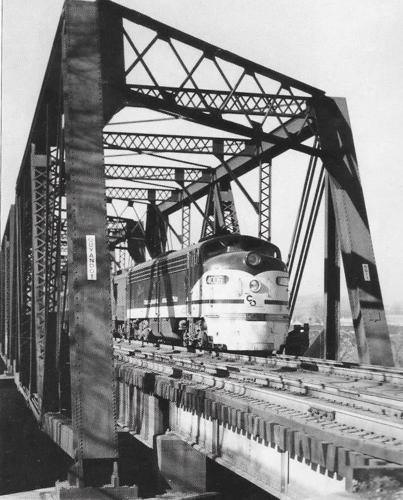
The C&O Goes Diesel
------------------------------------------------------------------------------------------------------

C&O diesel locomotive 4006 pulls a local passenger train
across
the railroadís Guyandotte Bridge on Thanksgiving Day in 1951
C&O Historical Society
------------------------------------------------------------------------------------------------------
When the nationís railroads, one by one,
began retiring their coal-fired steam engines,
replacing them with new diesel locomotives, the Chesapeake & Ohio Railway
was slow to join the trend. Itís easy to understand the C&Oís reluctance
to make the change when you realize that a significant share of its
annual earnings came from carrying coal from mine to market.
The switch from steam to diesel carried
distinct advantages for the
railroads making the change. Diesel engines are more efficient
than steam engines, meaning they can produce more
power with less fuel. This translated into lower
operating costs for the rail lines.
The C&O couldnít permanently ignore that
huge advantage.
Thus, in May 1949, the C&O ordered 146 diesel
locomotives. Almost immediately, it ordered
still more. The era of the steam
engine was over.
The accompanying photo, taken by noted
rail photographer
Gene Huddleston on Thanksgiving Day in 1951, shows E-8
locomotive No. 4006, part of a diesel fleet the C&O
ordered from General Motors. Itís pulling local
passenger train No. 16 across the
Guyandotte River at Huntington.
Local trains such as No. 16 once were a
vital part of the C&O network.
They carried passengers for short trips and delivered packages
and mail, stopping at every little town along the way.
They seemed to go everywhere. But by the
1960s, most of them were gone.
----------------------------------------------------------
Note: This Article and picture appeared in the Herald-Dispatch Newspaper on Feb. 27, 2024.
-----------------------------------------------------------
[ Back ]